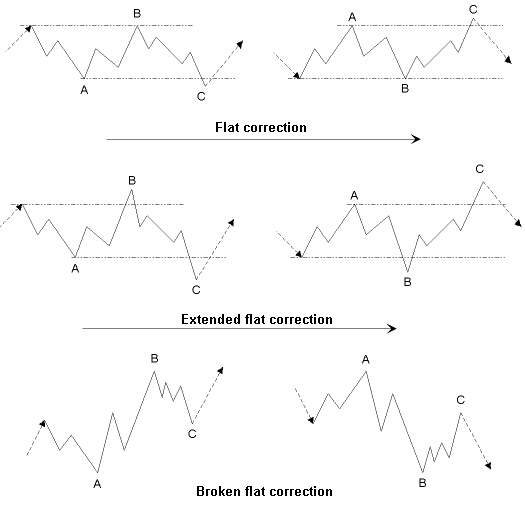Flat Corrections
Flat corrections are very common.

Figure 7.23: Flat corrections.
Special offer: “Capturing Profit with technical Analysis”
Note in figure 7.23 that waves A and B of a flat correction are both three-wave correction patterns. Wave C is an impulse pattern and usually does not pass much farther than the end of wave A.
Flat corrections mostly can be found in B waves, but they appear also in waves 2 and 4. In an extended flat correction, waves B and C move past wave A. In a broken flat correction, wave A is passed by wave B, but wave B is still a correction pattern.
Rules and Guidelines
- Wave A can be any correction pattern.
- Wave B can be any kind of correction pattern, except a triangle.
- Wave B takes at least 50% back of wave A.
- Wave B is never more than 200% of wave A.
- Wave C is an impulse wave or an ending wedge impulse pattern.
- Wave C is never more than 300% of wave A.
- Wave C is never more than 200% of waves A and B.
- Wave C moves into the territory of wave A.
Double and Triple Flat Corrections
Just like with the zigzag, in the flat correction, we have variants with a double and a triple flat correction.
A double flat correction is quite common, and a triple flat correction is rare.
A double flat correction is composed of two flat corrections connected via a correction pattern.
A triple flat correction is composed of three flat corrections connected via correction patterns.
We use WXY to denote a double flat correction, instead of the standard ABCXABC Elliott notation.
For the triple flat correction, this becomes WXYX²Z. This is a more consistent way of notation because more flat corrections of a lower order (ABC) are connected together by a higher order wave (XYZ).
Rules and Guidelines
- Wave W is any correction pattern, except a triangle or a double or triple pattern.
- Wave X is any correction pattern, except a triangle or a double or triple pattern.
- Wave X is a minimum 50% of wave W.
- Wave X is a maximum 400% of wave W.
- Wave Y is any correction pattern, except a double or triple pattern.
- Wave Y is bigger than wave X, except with a triangle pattern.
- Wave X² is any correction pattern, except a triangle or a double or triple pattern.
- Wave X² is a minimum 50% of wave Y.
- Wave X² is a maximum 400% of wave Y.
- Wave Z is any correction pattern, except a double or triple pattern.
- Wave Z is not a zigzag if wave Y is a zigzag.
Wave Z is bigger than wave X².